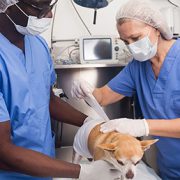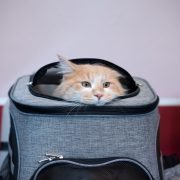Pathogenesis, transmission and response to re-exposure of SARS-CoV-2 in domestic cats
Pathogenesis, transmission and response to re-exposure of SARS-CoV-2 in domestic cats
Added 9 June 2020 | Updated 14 June 2021 Bosco-Rauth, A. M. et al. (2020) Experimental infection of domestic dogs and cats with SARS-CoV-2: Pathogenesis, transmission, and response to reexposure in cats. Proceedings of the National Academy of Sciences, 117 (42), pp. 26382-26388. https://doi.org/10.1073/pnas.2013102117 This is another small experimental study looking at response to exposure and transmission to SARS-CoV-2 in both cats and dogs. There were three parts to this study.
| ANIMALS | Intervention | Results |
| Cats – Group 1 (3 cats) | Inoculated intranasally with SARS-CoV-2 | None of the cats became clinically ill |
| Nasal and oral swabs taken on days 1,3, 5, 7, 10 and 14 for virus isolation and qPCR | Cats shed virus for up to 5 days with peak shedding at day 3 Viral levels from nasal swabs were higher than from oral swabs | |
| Blood collected weekly for 6 weeks for ELISA antibody measurement | Infected cats all developed detectable antibody by day 7, reaching or exceeding 1:2560 by day 14. Antibody titres stayed stable or increased between days 28-42 | |
| Re-exposed to virus at day 28 | Moderate increase in antibody titres noted 14 days after exposure | |
| Further swabs taken 1, 3, 7, 10 14 | No viral shedding detected after re-exposure | |
| Euthanased at day 42 | All three cats had mild lung changes, including mild interstitial lymphocytic pneumonia with peribronchiolar and perivascular lymphocytic cuffing and alveolar histiocytosis. | |
| Cats – Group 2 (4 cats) | Two cats inoculated with SARS-CoV-2 intranasally then co-housed with two other cats 48 hrs later. | |
| Nasal and oral swabs taken on days 1, 3, 5, 7, 10 and 14 | Inoculated cats shed virus as group 1.
Contact cats started shedding within 24 hours of being housed with infected cats but had more prolonged shedding with peak at 7 days post exposure | |
| Blood collected weekly for 6 weeks | All cats developed an antibody response | |
| 2 Inoculated cats euthanased on day 5 | Virus was isolated from trachea, nasal turbinates and oesophagus but was not found in the lung or other organs of either cat. | |
| Dogs (3 dogs) | Inoculated intranasally with SARS-CoV-2 | None of the dogs developed signs of disease |
| Nasal and oral swabs taken on days 1-5, 7, 10 and 14 | Viral shedding not detected | |
| Blood collected weekly for 6 weeks | Dogs developed neutralizing antibodies by 14 DPI and peaked at 21 DPI with titres between 1:40-1:80 | |
The authors conclude that cats are highly susceptible to subclinical infection, with a prolonged period of oral and nasal viral shedding, that is not accompanied by clinical signs. The study again shows that cats can become infected through direct contact with other infected cats. The authors also state that cats develop a robust neutralizing antibody response that prevented re-infection to a second viral challenge.
The dogs in this study did not appear to shed virus but did mount a low-level antibody response.





Leave a Reply
Want to join the discussion?Feel free to contribute!